Multiple channel types contribute to the low-voltage-activated calcium current in hippocampal CA3 pyramidal neurons
- PMID: 8795613
- PMCID: PMC6578965
- DOI: 10.1523/JNEUROSCI.16-18-05567.1996
Multiple channel types contribute to the low-voltage-activated calcium current in hippocampal CA3 pyramidal neurons
Abstract
Hippocampal neurons exhibit low-voltage-activated (LVA) and high-voltage-activated (HVA) calcium currents. We characterized the LVA current by recording whole-cell Ca2+ currents from acutely isolated rat hippocampal CA3 pyramidal neurons in 2 mM Ca2+. Long depolarizing steps to -50 mV revealed two components to the LVA current: transient and sustained. The transient phase had a fast decay time constant of 59 msec. The sustained phase persisted throughout the depolarization, even for steps lasting several seconds. The transient current was inhibited by the classic T-type channel antagonists Ni2+ and amiloride. The anticonvulsant phenytoin preferentially blocked the sustained phase, but ethosuximide had no effect. Steady-state inactivation of the transient component was half-maximal at -80 mV. Nimodipine, an L-type channel antagonist, partly inhibited the sustained current. BayK-8644, an L-type channel agonist, potentiated the sustained current. Calciseptine, another L-type channel antagonist, inhibited the sustained component. omega-Conotoxin-MVIIC, a nonselective toxin for HVA channels, had no effect on either of the LVA current components. omega-Grammotoxin-SIA, another nonselective toxin, partially inhibited the sustained component. The voltage dependence of activation of the nimodipine-sensitive current could be fit with a single Boltzmann, consistent with a homogenous population of L-type channels in CA3 neurons. Half-maximal activation of the nimodipine-sensitive current occurred at -30 mV, considerably more negative than the remaining HVA current. These results suggest that in physiologic Ca2+ more than one type of Ca2+ channel contributes to the LVA current in CA3 neurons. The transient current is carried by T-type channels. The sustained current is carried, at least in part, by dihydropyridine-sensitive channels. Thus, the designation "low-voltage-activated" should not be limited to T-type channels. These findings challenge the traditional designation of L-type channels as exclusively HVA and reveal a possible role in subthreshold Ca2+ signaling.
Figures
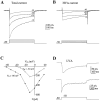

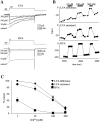

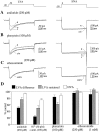


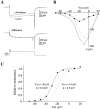
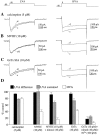
Similar articles
-
Evidence for multiple types of Ca2+ channels in acutely isolated hippocampal CA3 neurones of the guinea-pig.J Physiol. 1991 Feb;433:259-81. doi: 10.1113/jphysiol.1991.sp018425. J Physiol. 1991. PMID: 1668752 Free PMC article.
-
Characterization of single voltage-gated Na+ and Ca2+ channels in apical dendrites of rat CA1 pyramidal neurons.J Physiol. 1995 Aug 15;487(1):67-90. doi: 10.1113/jphysiol.1995.sp020862. J Physiol. 1995. PMID: 7473260 Free PMC article.
-
Whole-cell and single-channel calcium currents in guinea pig basal forebrain neurons.J Neurophysiol. 1994 Jun;71(6):2359-76. doi: 10.1152/jn.1994.71.6.2359. J Neurophysiol. 1994. PMID: 7931521
-
Voltage-dependent calcium channels.Gen Physiol Biophys. 2005 Jun;24 Suppl 1:1-78. Gen Physiol Biophys. 2005. PMID: 16096350 Review.
-
Pharmacology of recombinant low-voltage activated calcium channels.Curr Drug Targets CNS Neurol Disord. 2004 Apr;3(2):105-11. doi: 10.2174/1568007043482543. Curr Drug Targets CNS Neurol Disord. 2004. PMID: 15078185 Review.
Cited by
-
cAMP-dependent enhancement of dihydropyridine-sensitive calcium channel availability in hippocampal neurons.J Neurosci. 1997 Jul 15;17(14):5334-48. doi: 10.1523/JNEUROSCI.17-14-05334.1997. J Neurosci. 1997. PMID: 9204918 Free PMC article.
-
Cholinergic regulation of dendritic Ca2+ spikes controls firing mode of hippocampal CA3 pyramidal neurons.Proc Natl Acad Sci U S A. 2024 Nov 12;121(46):e2321501121. doi: 10.1073/pnas.2321501121. Epub 2024 Nov 6. Proc Natl Acad Sci U S A. 2024. PMID: 39503887 Free PMC article.
-
Coupling of L-type Ca2+ channels to KV7/KCNQ channels creates a novel, activity-dependent, homeostatic intrinsic plasticity.J Neurophysiol. 2008 Oct;100(4):1897-908. doi: 10.1152/jn.90346.2008. Epub 2008 Aug 20. J Neurophysiol. 2008. PMID: 18715900 Free PMC article.
-
Intracellular calcium store filling by an L-type calcium current in the basolateral amygdala at subthreshold membrane potentials.J Physiol. 2005 Jan 15;562(Pt 2):439-53. doi: 10.1113/jphysiol.2004.076711. Epub 2004 Nov 18. J Physiol. 2005. PMID: 15550460 Free PMC article.
-
A modelling study of locomotion-induced hyperpolarization of voltage threshold in cat lumbar motoneurones.J Physiol. 2002 Oct 15;544(2):521-36. doi: 10.1113/jphysiol.2002.026005. J Physiol. 2002. PMID: 12381824 Free PMC article.
References
-
- Armstrong CM, Matteson DR. Two distinct populations of calcium channels in a clonal line of pituitary cells. Science. 1985;227:65–67. - PubMed
Publication types
MeSH terms
Substances
Grants and funding
LinkOut - more resources
Full Text Sources
Other Literature Sources
Miscellaneous
